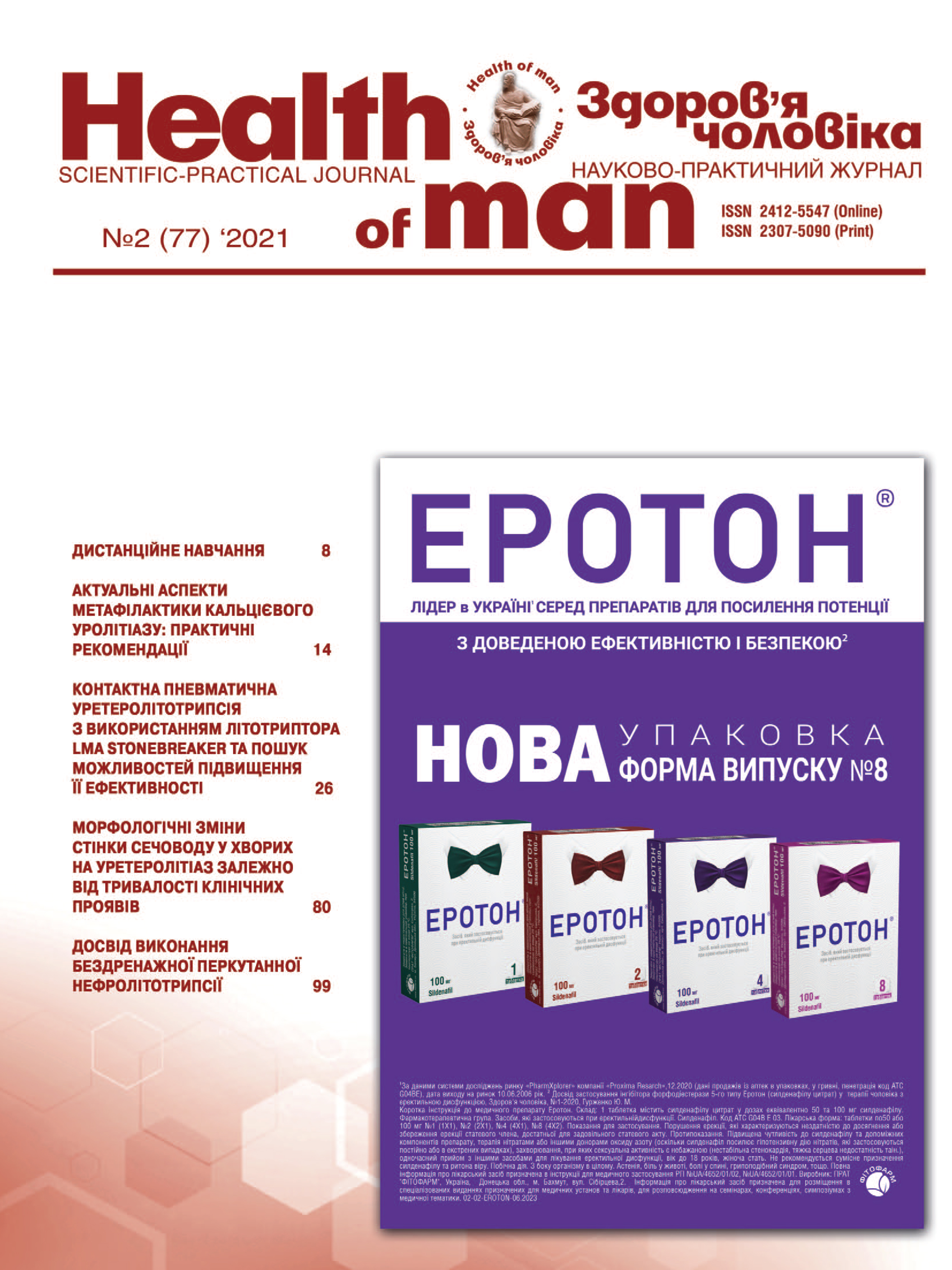Current Aspects of Metaphylaxis of Calcium Urolithiasis: Practical Recommendations
##plugins.themes.bootstrap3.article.main##
Abstract
Urolithiasis is a polyetiological and polypathogenetic disease. The modern task of treatment of SCC is not only the elimination of the calculus, but also the prevention and elimination of the causes that led to its formation. The lack of a comprehensive approach to the correction of metabolic disorders leads to the fact that 7-10% of patients after removal of the calculus relapse within 1 year, 35% - within 5 years and 50% of patients relapse within 10 years. The mean time to recurrence in every second patient is 8.8 ± 1.2 years.
The article presents current evidence-based data on possible options for metaphylaxis of various forms of calcium urolithiasis with recommendations on diet, lifestyle changes and drug treatment.
Special attention is paid to the use of the medicinal product of plant origin Canephron® N.
Systematic metaphylaxis, clear and coordinated succession in the work of the clinic and urological hospital, the patient’s commitment to the prescribed treatment contributes to a significant reduction in the frequency of recurrence of stone formation.
##plugins.themes.bootstrap3.article.details##

This work is licensed under a Creative Commons Attribution 4.0 International License.
Authors retain the copyright and grant the journal the first publication of original scientific articles under the Creative Commons Attribution 4.0 International License, which allows others to distribute work with acknowledgment of authorship and first publication in this journal.
References
Gajbullaev AA, Kariev SS. Vliyanie dlitel’nogo lecheniya preparatom Kanefron®N na pochechnye faktory riska, svyazannye s idiopaticheskim kal’cievym urolitiazom. Zdorov’e muzhchiny. 2013;1:190–4.
Gres’ AA, Voshchula VI, Rybina IL, Shloma LP. Mochekamennaya bolezn’: opyt primeneniya i ehffektivnost’ Kanefrona®N. Zdorov’e muzhchiny. 2006;1:116–9.
Davidov MI, Igoshev AM. Vliyanie rastitel’nogo preparata Kanefron®N na rezul’taty distancionnoj udarno-volnovoj litotripsii. Ehksperimental’naya i klinicheskaya urologiya. 2015;3:82–6.
Kostev FI, Krasilyuk LI, Bakhchiev RV, Lisak EL, Novikov MV. Primenenie Kanefrona N v ambulatornoj metafilaktike uratnogo litiaza. Zdorov’e muzhchiny. 2018;2:1–5.
Voshchula VI. Mochekamennaya bolezn’: ehtiopatogenez, diagnostika, lechenie I metafilaktika. Minsk: Zimaleto;2010. 220 р.
Nitkin DM. Obosnovanie korrekcii metabolicheskikh narushenij pri mochekamennoj bolezni (avtoref.): BeLMAPO.Mn. 2006. 22 p.
Chernenko VV, Shtil’vaser LM, Zheltovskaya NI. Sovremennye podkhody k pro- i metafilaktike mochekamennoj bolezni.Urologiya. 2005;4:1–4.
Borghi L, Meschi T, Amato F, et al. Urinary volume, water and recurrences in idiopathic calcium nephrolithiasis: a 5-year randomized prospective study. J Urol.1996;155:839.
Borghi L, Schianchi T, Meschi T, et al. Comparison of two diets for the prevention of recurrent stones in idiopathic hypercalciuria. N Engl J Med. 2002;346:77.
Ceban E. Efficacy of a fixed combination of Centaurii herba, Levistici radix and Rosmarini folium in Urolithiasis. Zeitschrift fur Phytotherapie. 2012;33:19–23.
Escribano J, Balaguer A, Pagone F, et al. Pharmacological interventions for preventing complications in idiopathic hypercalciuria. Cochrane Database Syst Rev. 2009: CD 004754.
Ferraro PM, Mandel EI, Curhan GC et al. Dietary Protein and Potassium, Diet-Dependent Net Acid Load, and Risk of Incident Kidney Stones. Clin J Am Soc Nephrol. 2016;11:1834.
Ferraro PM, Taylor EN, Gambaro G, Curhan GC. Vitamin D Intake and the Risk of Incident Kidney Stones. J Urol. 2017;197:405.
Fink HA, Wilt TJ, Eidman KE, et al. Medical management to prevent recurrent nephrolithiasis in adults: a systematic review for an American College of Physicians Clinical Guideline. Ann Intern Med. 2013;158:535.
Türk C. et al. Guidelines on urolithiasis. Eur. Assoc. of Urology. 2021. Available from: http://uroweb.org/wp-content/uploads/EAU-Guidelines-Urolithiasis-2021.pdf. – Date of access: 12.04.2021.
Johri N, Cooper B. An update and practical guide to renal stone management. Nephron Clin. Pract. 2010;3(116):159–71.
Qaseem A, Dallas P, Forciea MA, et al. Dietary and pharmacologic management to prevent recurrent nephrolithiasis in adults: a clinical practice guideline from the American College of Physicians. Ann Intern Med. 2014; 161:659.
Taylor EN, Curhan GC. Oxalate intake and the risk for nephrolithiasis. J Am Soc Nephrol. 2007;18:2198.





